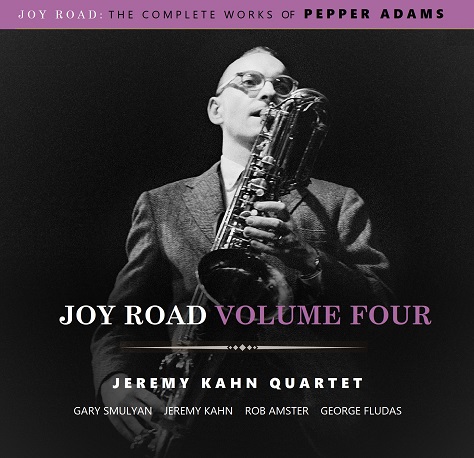
Although I had one nagging concern about the project, I chose not to voice it: When putting players together who have never played with each other (Gary Smulyan had never played with Rob Amster, George Fludas, or me), a “slam dunk” is not guaranteed, no matter how impressive the pedigree of the musicians involved. It’s just not possible to predict if a good musical chemistry will materialize in the short time allotted, even if the Producer has decided that there’s no reason why it shouldn’t. Also, no matter how sterling someone’s reputation, there’s no way of knowing how he will respond to unfamiliar (and difficult, as it turned out for us) material.
Certainly, going into the project, my preconception of Gary Smulyan was that he is a great player. My extremely limited knowledge of him included the fact that he had been in the Mel Lewis Orchestra for many years, and that, in the small world of great baritone sax players, he was considered to be the Baddest of the Badasses, our generation’s Pepper Adams. I also assumed that Pepper was, undoubtedly, a big influence on his musical approach.
Although I had never played with Gary. I think we crossed paths once in Brooklyn in the early ’80s at an ongoing, all-musician softball game in Prospect Park. This was a great hang. Guys like Tim Horner, Ed Howard, the Eubanks brothers, Michael Weiss, and Branford Marsalis, to name a few, used to come and play ball. It was a rotating cast of characters, and we called ourselves the “Reeferdome All-Stars,” but I digress.
A couple of months after making the Pepper Adams trio recording in 2006, serendipity dictated that my path would cross with Gary’s. My family and I took a trip to New York City, and I went to hear my old buddy Tim Horner sit in with the Vanguard Orchestra. (This was what the Thad Jones-Mel Lewis band was now called after Mel’s passing.) Who should be playing baritone sax? Why, it was none other than Gary Smulyan, playing some great stuff. (I recall a Pepper-like quote of “Harvest Moon” on the bridge of some Rhythm Changes.) And, since I had my bari-playing teenage son with me, I introduced myself to Gary on a break. He remembered me, and we had a real nice chat about many things, including the ongoing Pepper Adams recording project that was Gary Carner’s labor of love.
Little did Smulyan or I realize at the time that, within a few months, plans would be finalized for the two of us to embark on the next chapter of this Pepper-palooza. So, by early 2007, I needed to coordinate the music that had been chosen for this recording. Luckily, I had copies of the leadsheets that had been written out by Pepper (courtesy of Chicago bari sax guru Ron Kolber) for every tune except for one, a simple 12-bar blues.
These leadsheets were extremely helpful. I came to regard them as “Sacred Texts” that represented Pepper’s original intentions, no matter how much they may have evolved in various recordings. I arranged little intros and codas for the tunes, but, for the most part, I think that we played them fairly close to Pepper’s intentions. One exception, however, would be “Dylan’s Delight,” where, at the Producer’s request, I messed around with some (hopefully) Mingus-like sudden changes of time feel. But even that one was still pretty faithful to Pepper’s original concept, when it came to the solos. Okay, another exception would be “Diabolique II,” but that was just Rhythm Changes, performed as a duet for sax and drums, in which Gary and George simply let it fly in a minimally arranged fashion. These melodies that Pepper wrote were obviously best suited to be played by a baritone saxophonist, so it was great to have them in their “natural habitat.” Plus, I was just glad that someone other than me would be doing the bulk of the soloing.
At Gary Smulyan’s request, I was able to book a couple of nights for the quartet at Chicago’s coolest jazz venue, The Green Mill. The Garys arrived on Friday afternoon, and the weekend’s schedule shaped up thusly:
Friday: The Green Mill, 9pm-1:00am
That’s a whole lot of togetherness. I remember hoping, with great fervor, that Gary Smulyan would be 1) pleasant to be around, and 2) musically compatible with Rob, George, and myself. Otherwise, it could prove to be one seriously long-ass weekend.
I’m glad to report that the answer was a resounding “yes” to both. For our gigs at the Mill, we deliberately avoided any of the Pepper tunes, even though, on a certain level, it might have been helpful to use the gig as a rehearsal for the recording. But, truth be told, they were just too hard to risk playing them unrehearsed in front of a paying audience. Plus, Gary had just gotten over a three-week case of pneumonia, and he wanted to have fun playing with the band. Instead, we wisely chose a bunch of jazz standards with which we were all familiar and comfy. I think that this helped to quickly establish an underlying chemistry that enhanced this recording.
Regarding the tunes on this recording, or other Adams tunes I’ve played, Pepper Adams (like any jazz composer who is also a great instrumental soloist) clearly wrote his tunes as vehicles for himself; vehicles that would bring out the best in his playing. And these tunes are derived from the same genetic material as virtually all those that come from this post-Hard Bop style: a healthy mix of minor, major, and dominant chords, along with the usual ii-V-I chord progressions that can journey through a variety of tonal centers. Those of us who are given the challenge to create something beautiful from a piece of paper containing these kind of instructions eventually start to notice recognizable patterns after doing it a few hundred times, and these recognizable patterns create a comfort zone that enables the improviser to be relatively free from the burden of having to think too much. Why then, we all wondered in the recording studio, did Pepper’s tunes largely deny us that luxury? Our short answer: With the exception of the 12-bar blues and Rhythm Changes, while they did consist of the usual harmonic components, Adams’s unique combination of these components created a landscape that studiously avoided taking the soloist to the usual destinations, thereby making it difficult to ever really settle into a comfort zone. Because of this, I can honestly say that I’ve never played any tunes that were quite like Pepper’s.
If you feel you’ve achieved some degree of success in any new project, then the satisfaction you derive will be all the greater if it comes despite not having been allowed into your comfort zone during the process. We do hope that you appreciate our humble efforts at keeping these masterful works of the great Pepper Adams alive in these recordings by enjoying the contents herein.
Jeremy KahnMore Pepper Please
My first recording as part of this Pepper Adams project was a trio date in June of 2006. It must have gone well enough, because producer Gary Carner enlisted me for a second go-round with the trio, this time adding baritone saxophonist Gary Smulyan. It took place in June, 2007, in the same studio that had been the setting for our first session: Steve Ford’s great space on Clark Street in Chicago, with the mighty Grotrian piano.
Saturday: Recording, 1-5pm
Saturday: The Green Mill, 8pm-Midnight
Sunday: Recording, 3-11pm
January, 2008
| 1. | Enchilada Baby |

| ||
| 2. | Julian |

| ||
| 3. | Rue Serpente |

| ||
| 4. | Dylan’s Delight |

| ||
| 5. | Patrice |

| ||
| 6. | Now In Our Lives |

| ||
| 7. | Jirge |

| ||
| 8. | Hellure |

| ||
| 9. | Diabolique II |

| ||
Gary Smulyan, Baritone Saxophone
Rob Amster, Bass
George Fludas, Drums
John Larson, Engineer
Gary Carner, Producer
Recorded at Steve Ford Studio in Chicago, June 9-10, 2007
